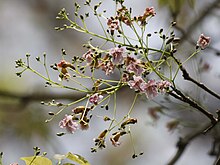en
names in breadcrumbs


Stereospermum chelonoides is a deciduous tree native to South and Southeast Asia.[1][3]
In Theravada Buddhism, this plant is said to have used as the tree for achieved enlightenment, or Bodhi by third Buddha called "Saranankara - සරණංකර", and twenty second Buddha "Vipassi - විපස්සි". The plant is known as පුලිල (pulila) in Sanskrit, పాదిరి (pādiri) in Telugu, පලොල් (palol) in Sinhala and পারুল (parul) in Bengali.
Stereospermum chelonoides is a deciduous tree native to South and Southeast Asia.
 Flower in Bangladesh
Flower in Bangladesh In Theravada Buddhism, this plant is said to have used as the tree for achieved enlightenment, or Bodhi by third Buddha called "Saranankara - සරණංකර", and twenty second Buddha "Vipassi - විපස්සි". The plant is known as පුලිල (pulila) in Sanskrit, పాదిరి (pādiri) in Telugu, පලොල් (palol) in Sinhala and পারুল (parul) in Bengali.